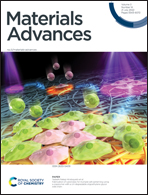Photoinduced degradation of thermally stable Cs2AgBiBr6 double perovskites by micro-Raman studies†
Abstract
The thermal stability of lead-free double perovskite Cs2AgBiBr6 for stable optoelectronic and photovoltaic devices is essential. There are contradicting reports, with some claiming stability from 300 to 400 °C based on X-ray diffraction and thermogravimetry studies and others up to 250 °C from Raman studies for Cs2AgBiBr6. We perform thermogravimetry analysis and temperature-dependent Raman studies with different laser intensities and show that Cs2AgBiBr6 is thermally stable up to ∼410 °C. A low power (3.68 mW) laser excitation source does not induce any structural changes at all temperatures. On the contrary, higher power laser light (7.15 mW) decomposes Cs2AgBiBr6 to Cs3Bi2Br9 at temperatures beyond 180 °C. Meticulous thermogravimetry, Raman, and X-ray diffraction studies confirm that Cs2AgBiBr6 is structurally stable up to 410 °C, whereas its stability decreases under light exposure beyond a certain critical intensity. This study brings out the importance of light and thermal stability of Cs2AgBiBr6, which is crucial for designing various optoelectronic devices.



 Please wait while we load your content...
Please wait while we load your content...